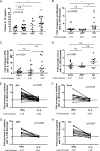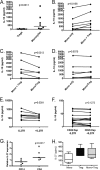CD4+ CD25+ regulatory T cells impair HIV-1-specific CD4 T cell responses by upregulating interleukin-10 production in monocytes
- PMID: 22496237
- PMCID: PMC3393541
- DOI: 10.1128/JVI.06251-11
CD4+ CD25+ regulatory T cells impair HIV-1-specific CD4 T cell responses by upregulating interleukin-10 production in monocytes
Abstract
T cell dysfunction in the presence of ongoing antigen exposure is a cardinal feature of chronic viral infections with persistent high viremia, including HIV-1. Although interleukin-10 (IL-10) has been implicated as an important mediator of this T cell dysfunction, the regulation of IL-10 production in chronic HIV-1 infection remains poorly understood. We demonstrated that IL-10 is elevated in the plasma of individuals with chronic HIV-1 infection and that blockade of IL-10 signaling results in a restoration of HIV-1-specific CD4 T cell proliferation, gamma interferon (IFN-γ) secretion, and, to a lesser extent, IL-2 production. Whereas IL-10 blockade leads to restoration of IFN-γ secretion by HIV-1-specific CD4 T cells in all categories of subjects investigated, significant enhancement of IL-2 production and improved proliferation of CD4 T helper cells are restricted to viremic individuals. In peripheral blood mononuclear cells (PBMCs), this IL-10 is produced primarily by CD14(+) monocytes, but its production is tightly controlled by regulatory T cells (Tregs), which produce little IL-10 directly. When Tregs are depleted from PBMCs of viremic individuals, the effect of the IL-10 signaling blockade is abolished and IL-10 production by monocytes decreases, while the production of proinflammatory cytokines, such as tumor necrosis factor alpha (TNF-α), increases. The regulation of IL-10 by Tregs appears to be mediated primarily by contact or paracrine-dependent mechanisms which involve IL-27. This work describes a novel mechanism by which regulatory T cells control IL-10 production and contribute to dysfunctional HIV-1-specific CD4 T cell help in chronic HIV-1 infection and provides a unique mechanistic insight into the role of regulatory T cells in immune exhaustion.
Figures





Similar articles
-
Differential impact of PD-1 and/or interleukin-10 blockade on HIV-1-specific CD4 T cell and antigen-presenting cell functions.J Virol. 2014 Mar;88(5):2508-18. doi: 10.1128/JVI.02034-13. Epub 2013 Dec 18. J Virol. 2014. PMID: 24352453 Free PMC article.
-
Immune Checkpoint Blockade Restores HIV-Specific CD4 T Cell Help for NK Cells.J Immunol. 2018 Aug 1;201(3):971-981. doi: 10.4049/jimmunol.1701551. Epub 2018 Jun 22. J Immunol. 2018. PMID: 29934472 Free PMC article.
-
Correlation between the degree of immune activation, production of IL-2 and FOXP3 expression in CD4+CD25+ T regulatory cells in HIV-1 infected persons under HAART.Int Immunopharmacol. 2009 Jul;9(7-8):831-6. doi: 10.1016/j.intimp.2009.03.009. Epub 2009 Mar 18. Int Immunopharmacol. 2009. PMID: 19303058
-
The Complex Dysregulations of CD4 T Cell Subtypes in HIV Infection.Int J Mol Sci. 2024 Jul 9;25(14):7512. doi: 10.3390/ijms25147512. Int J Mol Sci. 2024. PMID: 39062756 Free PMC article. Review.
-
Evaluating the potential of IL-27 as a novel therapeutic agent in HIV-1 infection.Cytokine Growth Factor Rev. 2013 Dec;24(6):571-7. doi: 10.1016/j.cytogfr.2013.07.001. Epub 2013 Aug 17. Cytokine Growth Factor Rev. 2013. PMID: 23962745 Free PMC article. Review.
Cited by
-
Immune-checkpoint expression in antigen-presenting cells (APCs) of cytomegaloviruses infection after transplantation: as a diagnostic biomarker.Arch Microbiol. 2023 Jul 10;205(8):280. doi: 10.1007/s00203-023-03623-8. Arch Microbiol. 2023. PMID: 37430000 Review.
-
Fallen angels or risen apes? A tale of the intricate complexities of imbalanced immune responses in the pathogenesis and progression of immune-mediated and viral cancers.Front Immunol. 2014 Mar 6;5:90. doi: 10.3389/fimmu.2014.00090. eCollection 2014. Front Immunol. 2014. PMID: 24639678 Free PMC article. Review.
-
HIV type 1 gp120-induced expansion of myeloid derived suppressor cells is dependent on interleukin 6 and suppresses immunity.J Infect Dis. 2014 Feb 1;209(3):441-51. doi: 10.1093/infdis/jit469. Epub 2013 Sep 1. J Infect Dis. 2014. PMID: 23999600 Free PMC article.
-
Differential impact of PD-1 and/or interleukin-10 blockade on HIV-1-specific CD4 T cell and antigen-presenting cell functions.J Virol. 2014 Mar;88(5):2508-18. doi: 10.1128/JVI.02034-13. Epub 2013 Dec 18. J Virol. 2014. PMID: 24352453 Free PMC article.
-
7-oxo-DHEA enhances impaired M. tuberculosis-specific T cell responses during HIV-TB coinfection.J Biomed Sci. 2020 Jan 6;27(1):20. doi: 10.1186/s12929-019-0604-z. J Biomed Sci. 2020. PMID: 31906962 Free PMC article.
References
-
- Ancuta P, et al. 2001. Opposite effects of IL-10 on the ability of dendritic cells and macrophages to replicate primary CXCR4-dependent HIV-1 strains. J. Immunol. 166:4244–4253 - PubMed
-
- Batten M, et al. 2008. Cutting edge: IL-27 is a potent inducer of IL-10 but not FoxP3 in murine T cells. J. Immunol. 180:2752–2756 - PubMed
-
- Blackburn SD, Wherry EJ. 2007. IL-10, T cell exhaustion and viral persistence. Trends Microbiol. 15:143–146 - PubMed
Publication types
MeSH terms
Substances
Grants and funding
LinkOut - more resources
Full Text Sources
Medical
Research Materials

